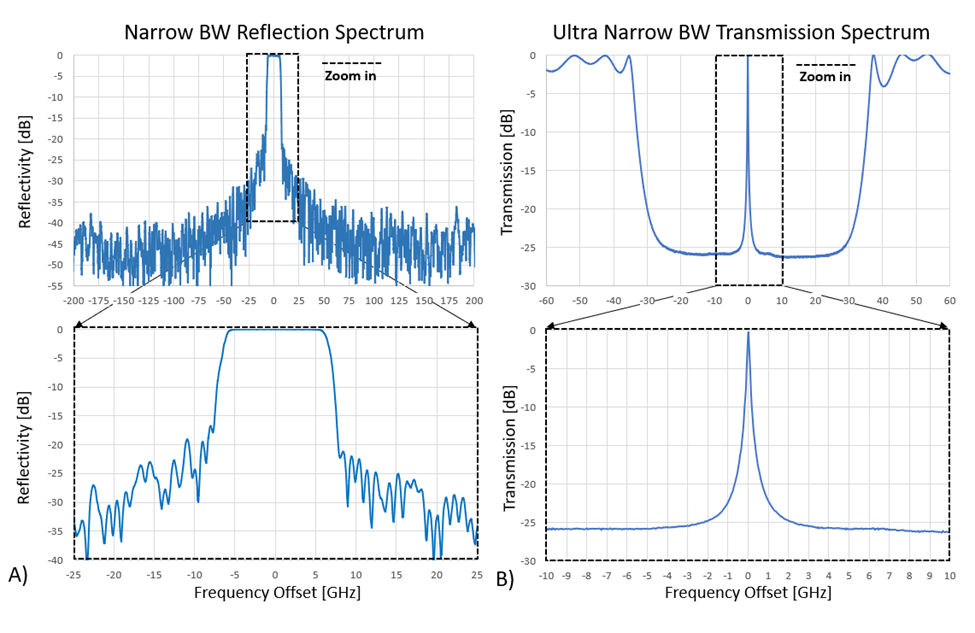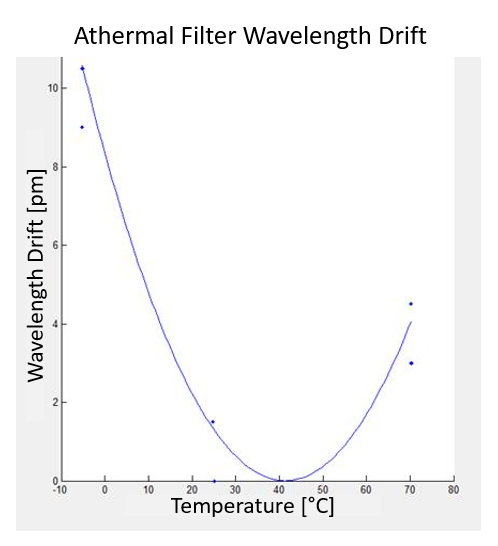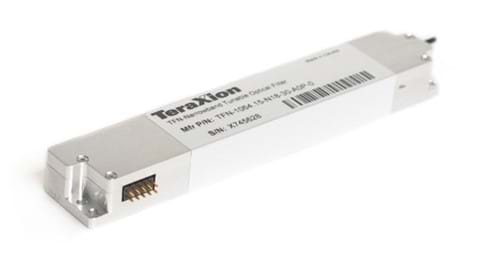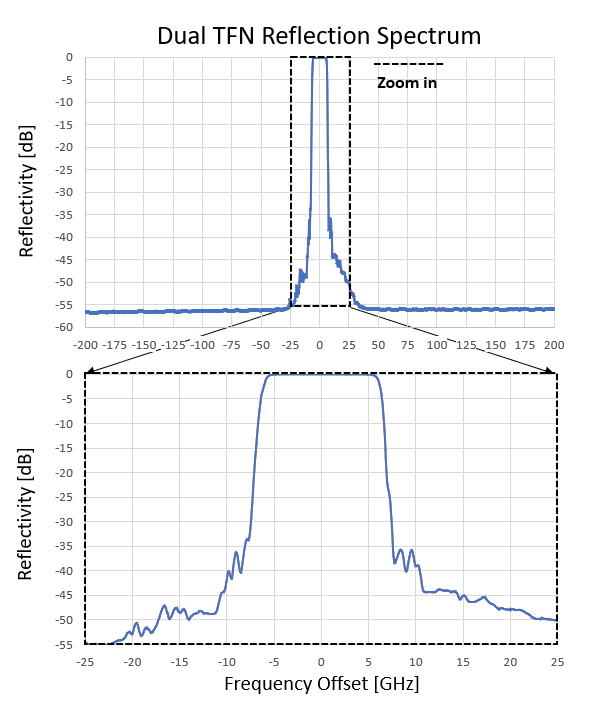Athermal vs. Tunable: What filter package should be used?
On: Apr 25, 2022
In: Optical Sensing & Optical Communication
Fiber Bragg gratings can be used to obtain different wavelength reflectivity profiles that depend on the refractive index pattern that is inscribed in the fiber. By relying on proven in-house design and simulation tools and state-of-the-art grating inscription methods, unique ultra-narrowband fiber-based optical filters can be realized. In addition to a bandwidth (BW) that can be as narrow as 2 GHz or 50 MHz, depending on the type of filter, fiber Bragg gratings filters exhibit the following qualities:
- Flat-top band
- Steep slopes
- High out-of-band optical isolation

Figure 1: Examples of TeraXion high-precision narrow filter spectra
a) Spectrum of a typical TeraXion narrow BW reflective filter with 13 GHz BW (full-width-half-maximum) that combines a flat-top, steep slopes and high optical isolation (up to 45-50 dB out-of-band, on average). TeraXion provides reflective filters as narrow as 2 GHz.
b) Spectrum of an ultra-narrow BW filter used in transmission. By an optimized phase shift in the grating, it is possible to generate an extremely narrow transmission window (from 50 to 500 MHz) in the center of a wide reflection band (between 40 and 100GHz).
One of the limitations associated with the use of narrowband filters is the temperature dependence of their central wavelength. A typical fiber Bragg grating filter in the C band (i.e. around 1550 nm) naturally drifts by about 10 pm/°C (1.25 GHz/°C), which can severely impact its performances, depending upon the application and operating environment.
To counter this drift, the grating can be encapsulated in a passive mechanical assembly which maintains its center wavelength over a specified temperature range. Another option is to actively stabilize the filter’s temperature using heating or cooling elements in a proper compact package. This second option also makes it possible to finely tune the filter’s center wavelength by adjusting the housing temperature.
TeraXion draws from more than 20 years of experience as a supplier of high value-added fiber Bragg gratings. The company has developed unique expertise in the use of athermal packaging and the temperature control of its fiber optic filters. The following sections compare these two approaches and present examples of applications for each solution.
Athermal filters

Athermal packaging is a passive solution that reduces the thermal drift of the Bragg grating to less than 0.5 pm/°C. This gain of a factor of 20 in stability provides a greater margin of maneuver to maintain a filter’s alignment within a few GHz on the signal of interest, thus guaranteeing the filter’s optimal functioning over all specified operating conditions.

Figure 2: The thermal drift curve of a Bragg grating filter equipped with athermal packaging.
The use of athermal filters is widespread in fiber optic distributed sensing (FODS) systems. Several manufacturers of FODS systems see an advantage in integrating filters as narrow as 5 to 15 GHz of BW into the interrogation unit. The filters are found in distributed acoustic sensing (DAS) systems using the Rayleigh effect as well as in distributed temperature and strain sensing (DTSS) systems using the Brillouin effect.
Another example of an application for the athermal filter is in the monitoring system of long-distance fiber-optic communication network integrity. It is also found in quantum communication systems, in particular for quantum key distribution applications.
The filter performs primarily the following functions:
- Filtering amplified stimulated emission (ASE) noise
- Isolating the Brillouin signal from the backscattered probe signal in the DTSS interrogators
- Suppressing Raman leaks from neighbouring channels in a channel of interest (for example, the channel reserved for quantum key distribution or network integrity monitoring).
In the application examples cited above, the typical manufacturing tolerance of ±50 pm on the central wavelength of the fiber Bragg grating is rarely problematic since the lasers used as the probe signal (or communication source) can be slightly wavelength adjusted. It is thus possible to align the source to fit the passive components of the detection chain. The recommendation to use an athermal filter thus depends on the system architecture and the type of source used.
At the application level, the use of a very narrow, flat-topped, steep-sloped, high-isolation filter maximizes the signal-to-noise ratio, which results in an increased detection range.
The design flexibility of fiber Bragg gratings also helps specify the BW to the nearest GHz, which represents the best compromise between performance and tolerance in terms of the filter’s alignment. You thus benefit from a high-performance passive filter adapted to your needs.
It should be noted that maintaining a minimum tolerance on the central wavelength when installing athermal packaging represents a considerable challenge. Knowledge and tight control of processes are required to maintain high precision within a batch of filters. TeraXion manages to maintain this tolerance within ± 50 pm.
Tunable Temperature Controlled Filter (TFN)

The most effective method to stabilize an optical fiber Bragg grating filter is to control its temperature. Adjusting the stabilization temperature also tunes the filter in wavelength. It is thus possible to ensure the filter’s optimal alignment on a signal of interest or a fixed detection chain. It is also possible to isolate different signals dynamically with a single filter.
TeraXion offers a Tunable Optical Filter (TFN) providing 2 pm resolution and ±30 GHz of tuning range. This product is widely used in radio frequency optical communication applications and optical detection systems where precise wavelength tuning provides added value. For example, when trying to interrogate different channels/signals a few GHz apart or when a system’s laser source is slaved to a frequency reference.
In general, the TFN is very well-suited to system architectures that take advantage of electro-optical modulators (EOMs) or nonlinear effects to generate different frequency tones. The TFN thus makes it possible to select a tone of interest or to isolate a sideband from the carrier, as required.
The temperature control approach also enables you to combine two fiber Bragg gratings in the same tunable platform to achieve greater optical isolation. TeraXion, for example, manufactures TFNs with more than 50 dB of optical isolation.

Figure 3: Reflectivity spectrum of a dual TFN filter at 13 GHz bandwidth (BW). The -57 dB maximum measured isolation is limited by the test instrument (we should expect 80 dB to 90 dB average out-of-band isolation based on the single FBG spectrum presented in Figure 1a).
Lastly, due to the extreme narrowness of their transmission band, phase-shifted type filters (figure 1b) are often integrated into the tunable platform to ensure optimal passband alignment.
Comparison table of TeraXion stabilization/control solutions for Bragg grating filters
| Parameter | Athermal | Temperature Controlled |
| Control interface | NA, passive filter | Software (I2C) |
| Center wavelength | From 700 nm to 2100 nm | From 700 nm to 2100 nm |
| Minimum bandwidth (reflection filter) | 2 GHz | 2 GHz |
| Minimum bandwith (ultra-narrow configuration) | 50 MHz | 50 MHz |
| Thermal drift | < 0.5 pm/°C | NA |
| Frequency tuning | NA | ± 30 GHz |
| Center wavelength accuracy | 50 pm | 2 pm of resolution |
| Dimensions | Short option: 4.8 x 75 mm / Long option: 6.3 x 195 mm | R: 130 x 22 x 14 mm / R+T: 150 x 54 x 19.5 mm |
Conclusion
Fiber Bragg grating technology makes it possible to realize very narrowband optical filters with flat tops, steep slopes and high isolation. Because of its narrow band, it is imperative to limit the filter’s wavelength drift to make sure that it optimally aligns with the signal of interest. TeraXion offers two solutions for the use of narrow optical filters for sensing and optical communication applications: the passive athermal package and the temperature-controlled filter (TFN).
Here are the main requirements and advantages that favour the choice of an athermal solution:
- High-performance optical filtering is required for a specific signal.
- Preference to use a more compact and passive filter, which does not consume electrical energy and is insensitive to electromagnetic interference.
- Cost optimization.
- Possibility of adjusting the light source in wavelength to adapt to the fiber Bragg grating’s manufacturing tolerances, as well as to the very low residual thermal drift of this packaging option (< 0.5 pm/°C ).
Through its tunability, the TFN adds flexibility to the filter’s alignment on one or more channels (± 30 GHz of excursion with 2 pm of resolution). It is recommended when:
- The application requires you to dynamically select or interrogate different close signals.
- The system architecture does not offer any degree of freedom on the alignment of the probe signal (in optical detection) or the communication signal.
- A tight optimal filter alignment provides a substantial gain in system performance.
- The application requires high optical isolation achievable by the combination of two fiber Bragg gratings (>50 dB) in a compact package.
- The application requires the use of phase-shifted Bragg gratings with an ultra-narrow transmission band (from 50 MHz up to 500 MHz BW).
TeraXion has been selling high-value fiber Bragg gratings for over 20 years. The company stands out for the quality, stability, and reliability of its products. It adheres to a rigorous process of defining and achieving technical requirements, leveraging its unique expertise.
Do you have any questions or wish to request a quote for one of these products? Contact us!
For more information about our complete line of passive filters, please consult our technical sheet:
For more information about our complete line of tunable optical filters (TFN), please consult our technical sheet:
Related Topics

High-Precision Optical Filters: ideal for amplified spontaneous emission (ASE) filtering, carrier suppression, side-band suppression, Brillouin isolation, Raman isolation, or any other optical sensing signal isolation requirement.
Ultra-Narrowband Tunable Optical Filter
The TFN tunable optical filter has been specifically designed for high-precision applications that require a high-optical isolation coupled with precise and accurate narrowband filtering.
